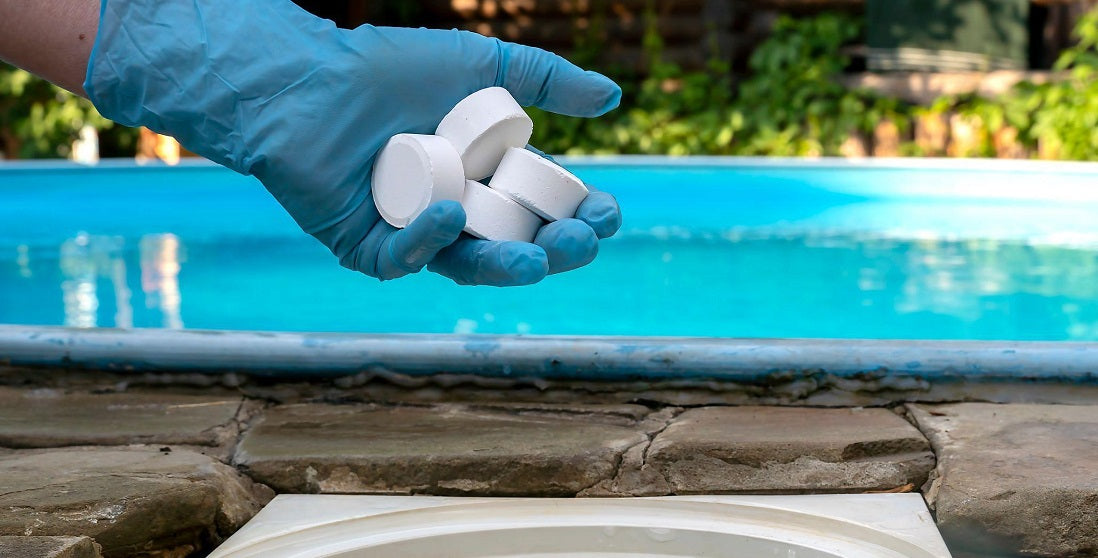Chlorine is a fantastic product to clean your swimming pool and keep it clean all summer. However, too much chlorine in the water can cause significant problems to a swimmer's health and the health of your pool and equipment.
If your swimming pool is reading high for chlorine concentration levels, lowering them before jumping in is best.
Luckily, there are many ways to do this, making it a quick and straightforward process so your fun in the sun lasts as long as your swimmers do.
How to Tell Your Chlorine Levels Are Too High

Woman testing chemicals in pool water The best way to tell where your chlorine levels register is by doing frequent tests with a pool chemical test kit. These are easy to obtain and very affordable.
Other indications a pool owner should watch for when determining whether or not you need to reduce the amount of chlorine in your pool include:
- Skin, eye, and lung irritation: Red eyes, sore throat, blurry vision, nausea, tightening of the chest
- Murky or cloudy water: Visibly cloudy and not crystal clear
- A strong smell similar to bleach: Easily noticeable and pungent odour, which is actually chloramine (a form of ammonia), since chlorine itself is odourless.
Lowering Pool Chlorine
Chlorine levels in a pool should appear on a testing strip between 1 and 4 ppm (parts per million). This safe amount will keep your pool from going green and turning murky but won't harm swimmers or your pool.
So, what can you do to lower your chlorine levels if they are showing up too high? A few different things, actually.
1. Add Some Pool Chemicals
Various pool chemicals are available to help lower the amount of chlorine concentration level in your water if it is reading too high. Some can easily be found in department stores or online shops, while others may require a visit to pool equipment supply stores.
A few chlorine neutralizer options you can try include:
- Sodium metabisulfite
- Sodium thiosulfate
- Sodium sulphite
- Ascorbic acid (vitamin C)
2. Close off the Output on Your Chlorine Dispenser
Your chlorine feeder or dispenser, typically a float placed in the pool, slowly dispenses the chemical from a solid chlorine tablet. These tabs are often 3 inches, and most pools will benefit from two to three tabs each week.
Chlorine floats have numerous slots, making it easy to choose how much of the chemical is released. If your pool has a high chlorine level, you may want to close off most of the slots, if not all of them, for a while.
Test your water levels regularly and keep the flow of chlorine low until they even out. Once the reading returns to where it needs to be, you can back up all the slots.
3. Dilute the Pool Water
Don't panic; we are not asking you to empty your pool completely. However, draining your pool and emptying 1/4 to 1/2 of the water can help quickly get rid of chlorine.
Adding fresh water to the pool once it’s drained will dilute the remaining chlorine, giving you safe swimming conditions. While this isn't the most popular option, it is one of the quickest and easiest ways to remove chlorine without chemicals.
4. Let the Sun Do the Work

Little girls swimming underwater giving thumbs up Another easy way to remove too much chlorine from pool water is by leaving the pool cover off and exposing it to sunlight.
This is one of the best options because it is 100% free and very effective. This works so well because the sun's UV rays cause a chemical reaction with the chlorine in your pool, helping it to dissipate into the air quickly.
5. Heat Your Pool if Possible
If you have a pool heater, heating the pool water can be an extremely effective way to lower chlorine levels. This is a popular option for hot tubs and indoor pools especially.
But those with outdoor pools can also utilize this option with a few buckets of boiling fresh water. Warm water creates the perfect conditions for breeding bacteria, which will use more chlorine to keep this problem at bay.
Monitor Levels Closely
First and foremost, always keep an eye on your pool readings. You can easily do this by purchasing a test kit that uses testing strips to measure the water's chemical levels.
When you attempt to remove chlorine from your pool, it can be easy to overdo it and remove too much. Keep a close eye on your levels to keep your levels between the recommended 2.0-4.0 ppm.
Final Thoughts
Too much chlorine in a pool can be dangerous and cause skin, eyes, and lung irritation. It can also damage your pool liner, clothes, and other objects because of its corrosive nature.
Instead of handling the effects of high chlorine levels after the fact, quickly dissipate this chemical using one of the great recommendations listed above. If you choose to purchase chlorine neutralizers, get them from a trusted and reliable source like PoolProductsCanada.ca.
FAQs
How much chlorine is too much?
Your pool's chlorine levels should read around 2.0-4.0 ppm. Anything higher than 4.0 ppm is not safe and requires dilution before swimming.
What is the best way to dilute pool chlorine?
We listed five great ways to lower your pool chlorine level effectively. The best options include heating the water, adding a chlorine neutralizer, exposing your pool water to the sun, reducing the chlorine being disbursed, and diluting your pool with fresh, non-chlorinated water.
Where can you purchase chlorine neutralizers?
For high-quality and effective chlorine neutralizers, you should check out specialty pool stores like PoolProductsCanada.ca.
Is too much chlorine dangerous?
Too much chlorine usage and chlorine exposure in a pool can be dangerous to those swimming in it and the pool itself. Keeping your chlorine levels in check will keep swimmers safe and help extend your pool's life.

